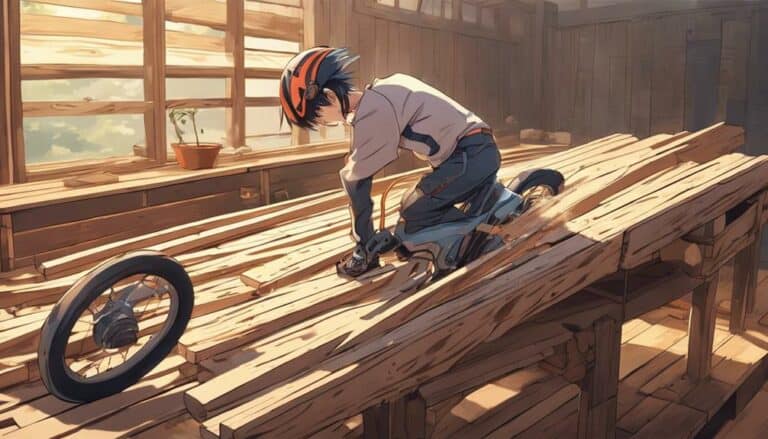If you've ever felt the thrill of conquering a challenge head-on, building ramps for a tiny dirt bike might just be the next step in your journey.
The process involves careful planning and precise execution, ensuring a safe and enjoyable experience for riders of all skill levels.
But what if there was a way to elevate your skills and take your jumps to new heights?
Stay tuned to discover some expert tips and tricks that could make a significant difference in your ramp-building game.
Key Takeaways
- Precise measurements and sturdy construction are essential for building safe and effective ramps.
- Design a smooth connection and a sturdy lip at the top for optimal performance.
- Use support boards and reinforcement for stability and durability.
- Finish with grip tape, sealant, and safety features for a professional and safe ramp.
Materials Needed
To construct a ramp for a tiny dirt bike, gather plywood pieces, smaller support boards, screws, measuring tools, and a saw. The plywood pieces will serve as the main structure of the ramp, typically cut in half to form the sides. Smaller boards are essential for providing additional support and stability to the ramp, ensuring it can withstand the weight and impact of the dirt bike. These materials, when combined strategically, create a sturdy foundation for the ramp.
For top performance and safety, it's vital to carefully select the right plywood pieces and smaller boards. The cost estimate for these materials is approximately $138, covering three plywood pieces and eight smaller boards. By investing in quality materials, you can guarantee a durable ramp that will withstand the rigors of dirt bike jumps and tricks. Prioritize the strength and durability of the plywood pieces and smaller boards to create a reliable ramp for your tiny dirt bike adventures.
Designing the Ramp
When designing the ramp for a tiny dirt bike, carefully consider the desired jump height, length, and angle to guarantee top performance and safety. To make sure a successful bike jump, follow these key steps:
- Measurements: Use precise measurements and sketches to plan the dimensions of the ramp. Pay close attention to the height, length, and angle to achieve the intended jump.
- Connection Design: Focus on creating a smooth connection from the ground to the top of the ramp. A well-designed connection guarantees a seamless flow for the tiny dirt bike when taking off.
- Lip Structure: Design a sturdy lip at the top of the ramp to provide the necessary launch point for the bike jump. The lip should be stable and well-supported to handle the pressure of the jump.
Building the Ramp Frame
Begin the construction of the ramp frame by measuring and cutting the plywood pieces for the kicker sides, making sure they're equal in size and suitable for the desired ramp height.
Next, start building by securing support boards at intervals along the length of the frame. Make sure the support boards are evenly spaced to provide ample support.
Cut out the connection design from plywood according to the desired shape, making a smooth fit with the support boards. To reinforce the structure, add additional support boards where necessary. These additional support boards will enhance stability and durability.
Finally, place the final layer of plywood on top of the support boards, securing it firmly in place. This will result in a solid and sturdy ramp frame for your tiny dirt bike.
Adding Support and Stability
For enhanced stability in your ramp frame, guarantee the support boards are firmly fastened and evenly spaced to create a sturdy foundation. When adding support and stability to your ramp, make sure to follow these key steps:
- Measure Accurately: Assure that the support boards are cut to the correct length and width as specified in the design plans.
- Secure Fastening: Use appropriate screws or nails to securely attach the support boards together, preventing any wobbling or movement.
- Even Spacing: Space the support boards one foot apart along the length of the ramp to provide consistent support and prevent any weak points.
Finishing Touches
To enhance the durability and safety of your ramp, consider sanding the edges smooth to prevent splinters and guarantee a secure riding experience. Once the sanding is complete, applying a weather-resistant sealant will protect the wood from moisture and extend the life of your ramp. For added traction and control during takeoffs and landings, adding grip tape or rubber matting to the surface is essential. This will make sure that your tiny dirt bike maneuvers smoothly without slipping. To add a touch of personalization and visibility, consider painting the ramp with high-visibility colors or designs. This not only enhances the aesthetics but also makes the ramp more visible during use. Additionally, installing handles or ropes for easy transportation and positioning of the ramp at different locations can further enhance the functionality of your ramp. By incorporating these finishing touches, you can create a sturdy, safe, and visually appealing ramp for your tiny dirt bike adventures.
| Finishing Touches | Description | Benefits |
|---|---|---|
| Sanding | Smooth edges prevent splinters | Enhanced safety |
| Weather-resistant Sealant | Protects wood from moisture | Prolongs ramp lifespan |
| Grip Tape | Provides traction and control | Prevents slipping during rides |
Conclusion
Now you have the ultimate tiny dirt bike ramp, ready to elevate your riding experience to new heights. With a solid frame, strategic design, and added stability, this ramp will launch you to the stars (not literally).
Remember to always prioritize safety and gradually improve your skills on the ramp. Get ready to soar like never before with your custom-built ramp!

